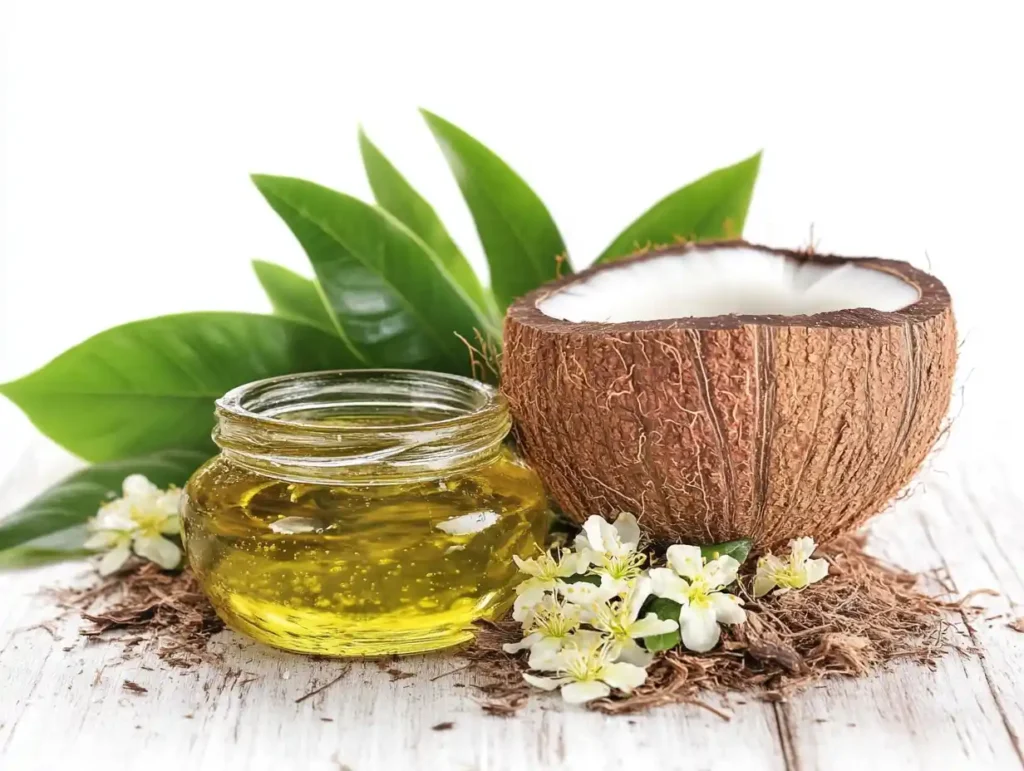When it comes to natural oils, each one offers unique benefits tailored to different hair types and needs. Here’s a closer look at how each of these oils works best for various hair textures, so you can find the perfect match for your strands!
1. Argan Oil for All Hair Types

Argan oil is an all-rounder, which is why it’s often recommended for any hair type—from straight to curly, fine to thick. Lightweight yet nourishing, it’s excellent for taming frizz and enhancing shine without weighing hair down. If you have thin or oily hair, a drop or two will smooth flyaways, while for thicker or curly hair, a few more drops can lock in moisture. Massage it through damp hair, focusing on the ends, to create softness and gloss. Check out this article on “The Magic of Argan Oil and Argan Shampoo: Your Guide to Gorgeous Hair. ”
Best for: All hair types, especially dry or frizzy hair.
2. Coconut Oil for Curly and Coarse Hair

Coconut oil is a must for those with curly, coarse, or thick hair due to its highly moisturizing properties. It penetrates deep into the hair shaft, reducing protein loss and giving curls a healthy bounce. Coconut oil is heavier than some other oils, so it’s especially helpful for combating dryness in thicker hair textures. Use it as a pre-wash treatment by massaging a small amount into dry hair and rinsing it out before shampooing.
Best for: Curly, thick, or coarse hair types.
3. Jojoba Oil for Oily or Fine Hair

For those with oily, fine, or thinning hair, jojoba oil is a lightweight option that won’t leave a greasy residue. Because it closely mimics the scalp’s natural oils, it helps balance oil production, making it ideal for anyone whose hair becomes oily quickly. This is also a great choice for maintaining a clean, healthy scalp without over-conditioning fine hair. You can apply a few drops to your scalp or add it to your conditioner for a subtle, healthy shine.
Best for: Fine, oily, or thin hair.
4. Olive Oil for Thick or Damaged Hair

Olive oil’s rich, moisturizing properties make it an excellent choice for thick, curly, or highly damaged hair. This heavier oil helps smooth rough cuticles, reduce frizz, and protect hair from further damage, making it ideal for those with thick or coarse hair who need deep hydration. Use it as an intensive conditioning treatment by applying a small amount to the lengths and ends, then wrap your hair in a warm towel for about 20 minutes before rinsing it out.
Best for: Thick, curly, or damaged hair.
5. Castor Oil for Hair Growth on All Types

Castor oil is revered for its hair growth benefits, making it a top pick if you’re looking to boost thickness and length. It’s very dense, so mixing it with a lighter oil like jojoba or coconut is recommended. Apply it to your scalp in small amounts, massaging it in to stimulate blood flow, and leave it on for at least an hour before washing it out. With regular use, castor oil can help fortify hair at the roots, giving your strands a stronger foundation.
Best for: Any hair type, particularly for those focused on hair growth.
How to Choose the Right Oil for Your Hair Needs

- For Shine and Manageability: Argan oil is the go-to for adding a glossy finish to any hair type without adding weight.
- For Deep Moisture and Repair: Opt for coconut or olive oil if your hair is thick, curly, or in need of some deep conditioning.
- For Oily or Fine Hair: Jojoba oil is a gentle moisturizer that won’t clog pores or add excess weight.
- For Scalp Health and Growth: Castor oil’s scalp-stimulating benefits make it ideal for anyone looking to promote growth, regardless of hair type.
Can You Use Multiple Oils at Once?
Using multiple types of oils in a hair care routine can bring various benefits, allowing you to address different needs all at once. For instance, combining castor oil with a lighter oil like jojoba or argan can offer the benefits of scalp stimulation for hair growth along with hydration for your lengths. You might apply a thicker oil such as coconut or olive to ends for deep conditioning, while a lighter oil like argan smooths and adds shine without weighing down roots. This method of layering or blending oils can give a comprehensive treatment, customized to your hair’s unique needs. Just remember, a little goes a long way, especially with multiple oils!
Know Before You Oil: Important Considerations for Safe Hair Care
Using oils for hair care comes with a few considerations. First, some oils, especially heavier ones like castor and coconut, can be difficult to rinse out, potentially leading to buildup or a greasy appearance on fine or oily hair types. Additionally, certain oils may clog pores or cause scalp irritation, particularly for sensitive skin. People with naturally oily scalps or conditions like seborrheic dermatitis should use oils sparingly or consult a dermatologist before trying them.
Those prone to acne or with sensitive skin should avoid oils like coconut or olive directly on the scalp, as they can clog pores around the hairline. Lastly, consider patch-testing a small amount of any new oil on the skin to ensure no allergic reaction occurs. The goal is to choose oils that match your hair type and scalp condition to avoid any unwanted effects.
Final Thoughts
Incorporating natural oils into your hair routine can be transformative, providing targeted benefits based on your hair’s unique needs. From boosting shine to enhancing strength and hydration, each oil offers its own advantages for different hair types. Whether you have thick, curly, fine, or colored hair, the right oil can make a noticeable difference. However, it’s essential to test oils in small amounts first, consider any potential sensitivities, and adjust usage to your hair’s response. Embrace the benefits thoughtfully, and enjoy healthier, naturally nourished hair!







